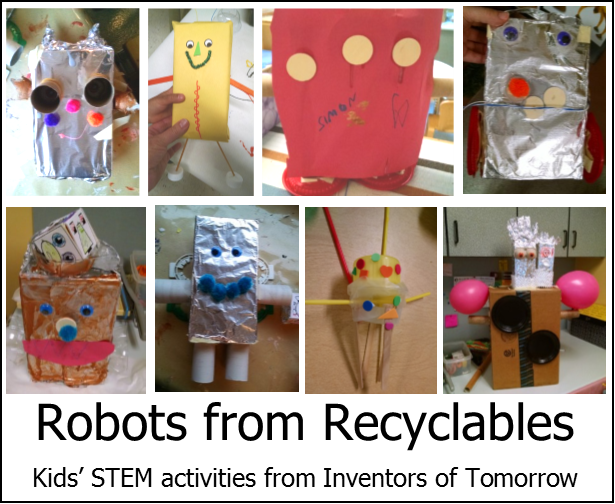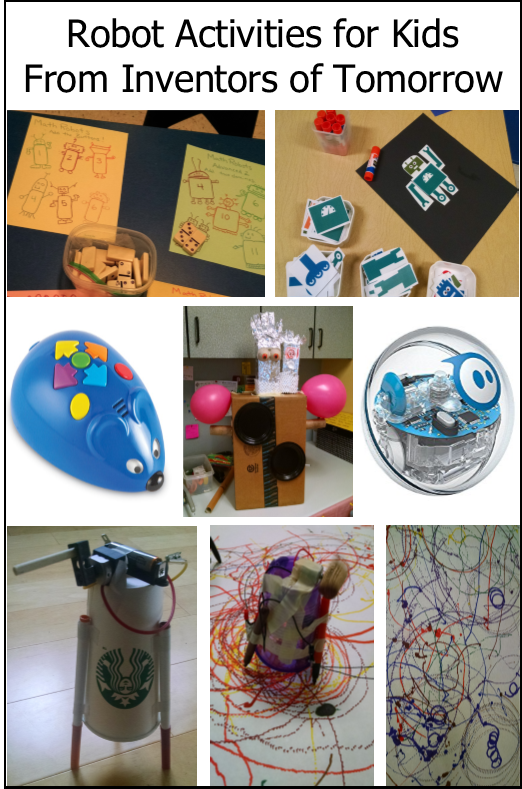Robots are a very popular topic for kids age 3 – 7, and is easy and fun to do in a preschool or kindergarten setting, home school, or at a robot-themed birthday party. Here are some fun activities.
Challenge Project
Build a Scribble-Bot
This is a parent-child project, not something that kids under 8 could do totally on their own.
Tape three markers to a over-turned plastic cup. Tape a 1.5-3v motor and a battery pack to the top of the cup. Mount a cork on the motor shaft to unbalance the motor. Take off the marker lids, connect the motor and the battery, and watch it scribble!
I have a complete tutorial with more lots photos and videos here: https://inventorsoftomorrow.com/2017/05/22/scribble-bots/.
Art Projects / Building
Model robots from recycled materials:
You can use small boxes, toilet paper tubes, and other fun materials, and build model robots. I have a full tutorial at https://inventorsoftomorrow.com/2020/06/04/robot-craft-from-recyclables/

In the tutorial, you’ll find fun ideas like creating arms that bend, eyes that light up and other engineering tricks.
Fun at Home with Kids has a nice “life-sized magnetic robot” which could be fun.
Robot Mix and Match
Take several large size boxes. Then enlarge images from this printable from Picklebums and tape them on the boxes We use three boxes with options for heads, one body box with a few different body choices, and a leg box with a different set of legs on each sided of the cube. We printed arms on card stock to tape on. Kids stack them up in different combinations to make different robots.
Duplo Robots: 
Build a robot with Duplos or Legos. I like this project from the Duplo simple machines kit. I like using Duplo kits in class, because the older kids can practice following pictorial directions and building the exact model described, and the little ones just free-play with the Duplos.
Art Projects
Build a robot picture. We use these great printables from Pickle-Bums. Plus paper, scissors, and glue sticks.
Assemble a 3-D or jointed robot: Print robot designs the kids could cut out and assemble – good small motor practice. Here are some printables you could try:
- 3-D, jointed robot from Education.com
- Jointed robots – instead of gluing on the arms and legs, fasten them on with brads so they can move: Church House, or Sparkle Box. Some of these could be mounted on popsicle sticks and used like puppets.
- Not a printable, but a paper robot puppet that walks, from Paper Magic.
Robot blocks: Using this printable from Create in the Chaos, kids colored in pictures, cut them out, and assembled them into blocks which could then be used as mix and match robots. Tip: You must print these on cardstock! Regular copy paper just couldn’t hold its shape as blocks. Best for ages 6 and up – they’re tricky to assemble. For this year’s class, we just printed a few color blocks and pre-assembled them for kids to play with.
Explore Robot Toys
There are lots or robot toys for kids to explore. Here are some we have tried (with Amazon Affiliate links… I do get a small referral fee if you make a purchase after clicking on this link, but the price is the same for you.) You can read my full reviews of robot toys for more details.
This crab shaped Table Top Robot ($11) is very fun… you turn it on, set it on a table, and it scuttles sideways till it hits the edge of the table, then turns, and scuttles till it reaches an edge again.
Code & Go Robot Mouse and maze ($39). This programmable mouse allows you to type in a code (forward, forward, left, forward), then press a button to move the mouse robot through its maze.
Sphero SPRK+ STEAM Educational Robot. You use a smart phone app as a remote control to drive this little ball all around the room. At its top speed, it really zips!
Cubelets robot blocks. These probably don’t seem like robots to anyone who is expecting a humanoid shape. But, they do have a sensor that activates them and makes them move. (It’s just a switch, so they don’t really have a “processor.”)
Math and Learning Activities
Design Process Worksheet
I’ve created a worksheet kids can complete to brainstorm ideas for what kind of robot they would want to invent. What job would it do? What sensors and actuators would it need to do that job? Then they can draw out their idea. Find the Robot Design Worksheet here.

More Learning Activities
I made up some domino math sheets with a robot theme…. the idea was taken directly from Katherine Marie.
I made a Robot Job Matching Game, (click there for a free printable of it) by collecting pictures of robots doing a job and humans doing the same job so kids could match them up. I wanted to illustrate that humans create robots to do jobs they can’t do or don’t want to do or want to automate.
Robot game: We have a Build a Robot spinner game, plus a board game called Robot Turtles
which plays with the idea of a robot following its commands and with teaching the basics of programming to small children. [I would recommend that if you’re starting with a 3 or 4-year-old, you start even easier than the game tells you to start. Just introduce the basic idea of them moving the turtle only when you command it (or you move when they command) – you don’t even need to use cards. Then add the cards in to do the directions. Then over time add in the other elements for the game.]
Coding Game Online: There’s an online Star Wars themed coding game: https://code.org/starwars. It teaches the skill of dragging in blocks of commands, then running the program and seeing if the droid does what you wanted it to. Our five-year-old can do this, but I wouldn’t expect a 3 or 4-year-old to be able to understand. It builds on the programming ideas taught by the robot mouse or the Robot Turtles game.
Snacks:
If you’re hosting a robot birthday party, here’s a few ideas: A bowl of snack mix… pretzel rods, cheerios, and Chex with a sign saying “nuts and bolts” and string cheese or licorice ropes with a sign saying “wires” and maybe some candy shapes for “buttons”.
Pinterest is full of pictures of robots assembled with mini raisin boxes for feet, juice box for a body and an upside down applesauce cup for a head. Looks cute, but that’s a lot of fructose for one sitting. Inspiration Made Simple has a cute robot lunch, including sandwich, cheese, and celery.
Ideas to Teach
In our circle time, we ask: What’s a robot? (A machine people build that does stuff.) Why would we want to build robots? (To do things we can’t do or don’t want to do.) What makes a robot different from other machines? (A true robot has three things: sensors, processor, and actuator.) We use the crab robot (see above) and a Roomba Vacuum Cleaner to demo these ideas.
Song: Fingerplays and Action Rhymes has a simple song to the tune Wheels on the Bus.
 Book: I wrote my own book for this class. Robots. (Click there for a free printable book.) It addresses all the basic concepts I cover in this post, with a special focus on biomimicry. I also have a post on recommended kids books about robots.
Book: I wrote my own book for this class. Robots. (Click there for a free printable book.) It addresses all the basic concepts I cover in this post, with a special focus on biomimicry. I also have a post on recommended kids books about robots.
We do this topic as the final session in our Biology unit. We explained that robots are machines that humans build to do jobs that humans don’t want to do or can’t do. We talked about Biomimicry and how robot inventors take ideas from nature and evolutionary adaptations.
I also made a companion video which includes video clips of lots of different nature inspired robots and videos of the animals that inspired them.
Group Games
Robot Maze: With one or two kids, you could do a life-size version of Robot Turtles game / the robot mice: Tape out a maze on the floor, with a goal (a jewel or a piece of cheese). Give a child commands to get there – they can only move when you command them. OR have one child be the turtle / mouse, and the other child commands them.
The Robot’s Programmer Says: We play a game that is basically Simon Says. We explained that robots can’t decide for themselves what to do. They can only follow their programming. So, one teacher was the programmer, saying things like “Robots, put your right hand up.” “Robots, put your right hand down.” “Robots, jump 5 times.” The other teacher would give commands, but the robots “couldn’t hear them” because they weren’t in its programming. “Hey, wouldn’t it be fun to spin around and around?” “Can you put your hands on your head?”
Don’t miss these related posts: Robot Toys for Young Kids, Robot Books, Robot Craft from Recyclables.














[…] Click here for LOTS of ideas for hands-on STEM activities to learn about Robots. […]
LikeLike